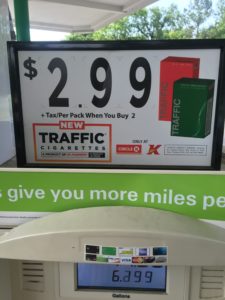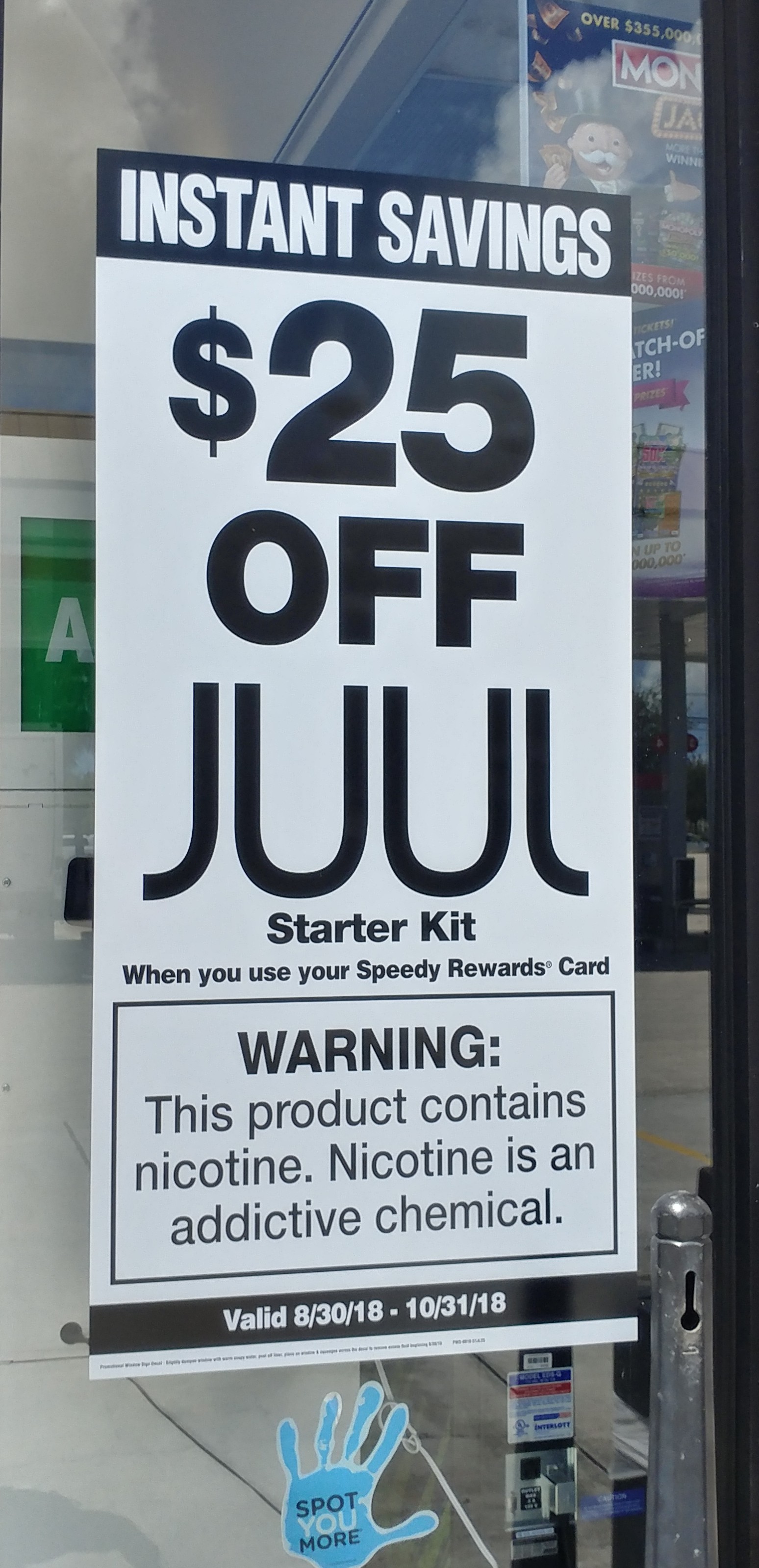Welcome to CounterTobacco.org’s “News and Research Roundup!” Each month we post a summary of the latest research, reports, and news stories on counteracting tobacco product sales and marketing at the point of sale (POS). Keeping up with what’s happening in the POS movement all across the country can help you choose policies and strategies that work best for your community. New research can help provide support for your work and evidence for the importance of the “War in the Store.” Have a story you don’t want us to miss? E-mail it to us!
New Research
Pricing
- Neighbourhood disparities in the price of the cheapest cigarettes in the USA, Journal of Epidemiology and Community Health
 Surveys in a representative sample of 2069 tobacco retailers across the US in 2015 found that the average price for the cheapest pack of cigarettes was lower in neighborhoods with a greater proportion of youth and in neighborhoods with lower median household income. While across the US, the average price for the cheapest pack of cigarettes was $5.17, the price was $0.04 cheaper for every standard deviation increase in the percentage of youth living in the neighborhood. Prices were also $0.22 cheaper in neighborhoods with the lowest median household income compared to the highest median household income. Additionally, the cheapest price was discounted in 19.7% of stores. Researchers suggest that non-tax price policies such as minimum price laws and prohibiting the redemption of coupons and discounts may help raise the price of cheap cigarettes.
Surveys in a representative sample of 2069 tobacco retailers across the US in 2015 found that the average price for the cheapest pack of cigarettes was lower in neighborhoods with a greater proportion of youth and in neighborhoods with lower median household income. While across the US, the average price for the cheapest pack of cigarettes was $5.17, the price was $0.04 cheaper for every standard deviation increase in the percentage of youth living in the neighborhood. Prices were also $0.22 cheaper in neighborhoods with the lowest median household income compared to the highest median household income. Additionally, the cheapest price was discounted in 19.7% of stores. Researchers suggest that non-tax price policies such as minimum price laws and prohibiting the redemption of coupons and discounts may help raise the price of cheap cigarettes.- Learn more about non-tax price policies.
- Impact of e-cigarette and cigarette prices on youth and young adult e-cigarette and cigarette behavior: evidence from a national longitudinal cohort, Tobacco Control
- This study found that amongst a national cohort of youth ages 15-21 followed over the course of 2.5 years, when cigarettes prices were higher, past 30-day e-cigarette use increased. However, no significant association was found between the price of rechargeable e-cigarettes and either past 30-day e-cigarette use or past 30-day cigarette smoking.
Policy Implementation and Enforcement
- Assessment of Underage Sales Violations in Tobacco Stores and Vape Shops, JAMA Pediatrics
- Data from the 2018 California Tobacco Control Program’s Young Adult Tobacco Purchase Survey, which uses 18-19-year-olds as underage decoys to attempt to purchase either cigarettes or vape product, found that about half (49.8%) of tobacco and vape shops that primarily sell tobacco products did not check IDs for the youth, and 44.7% sold to them. The rates of sales to underage youth in these types of stores was significantly higher than in other types of stores. This underscores the need for strong age-verification requirements and strong enforcement efforts, including, as study authors suggest, an increase in the number and frequency of FDA compliance checks.
- News story: Half of tobacco and vape shops don’t ID teens, undercover research finds, CNN
- Tobacco Advertising and ID Checks in Columbus, Ohio, in Advance of Tobacco 21, American Journal of Health Promotion
- In December 2016, Columbus, OH passed a policy raising the minimum legal sales age for tobacco to 21. Prior to enforcement of the new ordinance, which began in the fall 2017, fieldworkers ages 20-21 assessed a proportional, stratified random sample of retailers in Franklin County (where Columbus is located) and assessed those stores for store type, exterior advertising, whether they check IDs (as required by federal law for anyone younger than 27), and whether they sold to the 20-21 year-olds. Among stores where the fieldworkers were able to purchase cigarettes, 61.1% did not check IDs. Convenience stores and tobacco shops were more likely to not check IDs, as were stores with greater amounts of exterior tobacco advertising.
- Implementation of the New York City Policy Restricting Sales of Flavored Non-Cigarette Tobacco Products, Health Education & Behavior
- New York City’s policy restricting the sale of flavored non-cigarette tobacco products involved extensive groundwork to educate both the public and decision makers about the need for this type of policy. Despite challenges from the tobacco industry, the law was implemented and withstood those challenges. To ensure compliance with the policy, the city integrated enforcement into ongoing retailer compliance monitoring, and have found low levels of violations.
Menthol
- Ban on menthol-flavoured tobacco products predicts cigarette cessation at 1 year: a population cohort study, Tobacco Control

- A study conducting in Ontario before and after the province’s ban on menthol-flavored tobacco products found that 1 year after the ban was implemented, people who smoked menthol cigarettes daily or occasionally had higher quit rates than people who smoked non-menthol cigarettes.
- Use of Mentholated Cigarettes and Likelihood of Smoking Cessation in the United States: A Meta-Analysis, Nicotine & Tobacco Research
- While this meta-analysis did not find a significant association between use of menthol cigarettes and cessation overall, they did find that African-Americans who smoked menthol cigarettes were about 12% less likely to quit smoking compared to African-Americans who smoked non-menthol cigarettes.
- Study underscores role of menthol cigarettes in smoking cessation, University of Buffalo News Center
- Learn more about menthol.
Other
- Unplanned purchasing of tobacco products: beyond point of sale display, Health Promotion Journal of Australia
- This study was conducted in Western Australia among adults ages 25-54 who were either current smokers or had quit in the past 4-5 weeks. Of all the participants, 64% had tried to quit smoking within the last 2 years, but 96% had relapsed. Almost one-third (30%) of participants reported impulse, or unplanned, purchases of cigarettes, and 16% reported impulse purchases at least once per week. The reasons for these purchases included running out of cigarettes (45%), loss of willpower (18.3%), triggers such as alcohol, cravings, being around other smokers, and being at the checkout where cigarettes are sold (5%). While supermarkets were the most common usual point of purchase for cigarettes for 78% of participants, they were the location for the first cigarette purchase during relapse for only 52% or participants. Researchers suggest that price boards and other factors in the retail environment could trigger unplanned purchases related to avoiding running low on cigarettes, and reducing the number of tobacco retailers could help reduce triggers for impulse purchases.
- Health claims made in vape shops: an observational study and content analysis, Tobacco Control
- An observational study from before the deeming rule was implemented found that across 46 vape shops in North Carolina, 41% displayed at least one health claim. The most common type of health claim (62.2%) was that vaping could be used for cessation purposes, and over a quarter (27.4%) made a modified risk claim. Chain vape shops were more like to make health claims (88.9%) compared to independently-owned shops (11.1%). These types of claims are now all prohibited under the FDA’s deeming rule, but researcher suggest these findings underscore the need for retailer education, continued surveillance, and enforcement regarding advertising health claims.
New Reports
- Tobacco Nation: An ongoing crisis, Truth Initiative
Industry News
- Altria Enters Growing Oral Nicotine Products Category with on! Pouch Product, Altria
- Other Tobacco Products Offset Cigarette Losses in 2018, CSP Daily News
- PMI Launches Online Hub Offering Inspiration to ‘Unsmokers,’ Business Wire
- Cigarette price hikes on the way – again, Winston-Salem Journal
- Analysts project very-low-nicotine traditional cigarettes would plunge manufacturers’ profits by 2034, Winston-Salem Journal
POS Policy in the Media
- Beverly Hills Votes to End Most Tobacco Sales, US News
- Citywide tobacco sales ban considered, Easy Ready News
- Tobacco’s ‘Special Friend’: What Internal Documents Say About Mitch McConnell, NPR
- Wildomar council passes moratorium on new tobacco, hookah, and vape shops, Valley News
Menthol and Other Flavored Tobacco Products
- Flavored tobacco sales to be banned in Aspen, Aspen Daily News
- San Rafael flavored tobacco ban clears last hurdle, Marin Independent Journal
- Lee, Lenox, Stockbridge join list in banning sales of flavored, noncigarette tobacco products, Berkshire Eagle
- Brookline Bans Sale of Flavored Tobacco, Including Menthol, Patch
- Santa Cruz County to ban flavored tobacco, e-cigarettes, Santa Cruz Sentinel
E-Cigarettes
- San Francisco Bans Sales of E-Cigarettes, NPR
- Juul move to block SF e-cigs ban is a page out of Big Tobacco’s playbook, critics say, San Francisco Chronicle
- Two more California cities consider bills banning e-cigarettes, modeled after SF law, San Francisco Chronicle
- Federal watchdogs warn vaping companies over online marketing practices, CBS News
- House panel demands internal documents from Juul in teen vaping probe, CNBC
- Juul’s New Marketing is Straight Out of Big Tobacco’s Playbook, The Atlantic
- The debate over e-cigarettes demands stronger evidence of their value, Nature
- A crackdown on Juul made vaping more expensive for some teens, MarketWatch
- Ex-FDA chief Scott Gottlieb: ‘Juul is going to be in a hard spot to ever get their product approved,’ CNBC
- Juul is exploring plans to open its own US retail shops, CNBC
- Attorney General Maura Healey sues e-cigarette company Eonsmoke saying its targeting teens, underage users, Mass Live
Tobacco 21
- Lamont signs bills increasing Connecticut’s smoking age to 21, Washington Post
- McConnell’s Tobacco 21 Bill Exposes States to Big Tobacco’s Wishlist, Sludge
- Texas Gov. Abbott signs law making 21 legal age to buy tobacco products, Fox News
- Hennepin County looks to raise age to buy tobacco from 18 to 21, Star Tribune
- Big Y Foods raises tobacco age requirement chainwide, Supermarket News
- Flagstaff council votes to ban sale of tobacco to people under 21, AZ Daily Sun
Find more stories in last month’s News and Research Roundup.
Know of a story that we missed? Email us, and we’ll be sure to include it in next month’s roundup!


